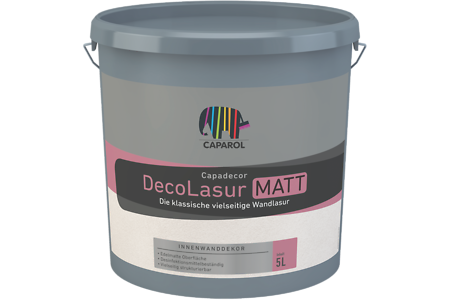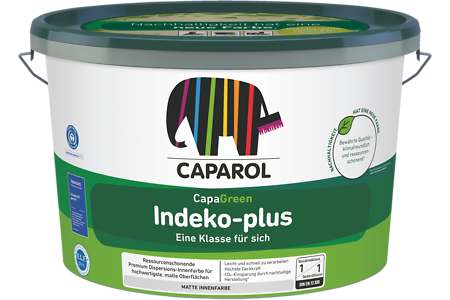Field of Application
ArteTwin is a highly appealing, multicoloured surface-effect wall designing (surface treatment/stopping) technique, suitable to produce natural, elegant looking interior wall surfaces.ArteTwin Technique consists of specially developed components, which may be combined individually. Unobtrusive up to impressive surface effects are achievable by variable use of the products and different working methods/techniques.
Specialty:
By means of a specially developed trowel a minimum of 2 products is applied (Twin Technique).
Bright pigmented particles, unmixable with other colour pigments, are part of ArteTwin Basic and ArteTwin Effect. They produce a unique visual appearance. The particles are exposed during application and natural application textures arise, being symptomatic for this type of technique.
Capadecor ArteTwin is patent-protected.
Material Properties
- Water-dilutable.
- Ready to use.
- Ecologically compatible, low odour.
- Tintable via ColorExpress.
- Cleanable.
- Reaction to fire as per German standard DIN 4102-A2: non-combustible.
Material Base / Vehicle
Acrylic dispersion/emulsionPackaging/Package Size
5 litres, 10 litres
Colours
White (hiding/covering) with white particles. Can be tinted via ColorExpress in approx. 300 colours
(on the basis of Caparol 3D System plus) according to the ColorExpress Collection "CD-ArteTwin".
Advice for Designing:
Material rates and products themselves may individually be varied, depending on the desired visual appearance and designing objective.
The basic tints should be colour coordinated (harmonic colours) or should match in lightness/brightness (luminosity) to obtain homogeneous surfaces, avoiding an unbalanced surface impression.
Gloss Level
Dull matt (Dead-matt according to DIN EN 13300)
Storage
Keep in a cool, but frost-free place.Keep partially used buckets/containers always tightly closed.
Supplementary Product
- Indeko-plus
- ArteTwin Effekt Gold
- ArteTwin Effekt Silber (Silver)
Suitability according to Technical Information No. 606 Definition of Application Areas
| Interior 1 | Interior 2 | Interior 3 | Exterior 1 | Exterior 2 |
| + | + | ○ | – | – |
| (–) inapplicable / (○) of limited suitability / (+) suitable | ||||
Suitable Substrates
Interior substrates: Plasters in mortar group PII (lime-cement mortars), PIII (cement mortars), PIV (ready-mixed gypsum plaster), gypsum building boards/wallboards, plasterboards (sandwich-type plaster boards/drywalls) and concrete.
Substrate requirement for gypsum plaster and gypsum building boards/wallboards: The substrate has to match quality level Q3.
Minimum requirement for all other substrates: The substrate must be pore-free, free of shrink holes and should comply with the increased requirements of German standard DIN 18202 (size tolerances for structural engineering).
The substrates must be dry, clean, sound/stable and free from all substances that may prevent good adhesion. Germany: Follow VOB, part C, DIN 18363, section 3.
Substrate Preparation
Advice:Roughly and unevenly textured substrates must be smoothened with Caparol Akkordspachtel fein (fine) or mittel (medium) or with AkkordLeichtspachtel.
Alkaline substrates are unsuitable and cannot be coated with ArteTwin. These substrates must always be pretreated by suitable means.
Plasters in Mortar Groups/Classes PII and PIII:
Solid substrates with normal absorbency: Apply one priming coat of Capadecor DecoGrund or Caparol-Haftgrund. Prime slightly sanding, absorbent substrates with CapaSol. Prime more sanding surfaces with Caparol-Tiefgrund TB or AmphiSilan-Putzfestiger.
Gypsum and Ready-Mixed Gypsum Plasters in Mortar Group PIV:
Sand/grind off sintered skin and remove all abrasive dust. Apply one priming coat of Capadecor DecoGrund or Caparol-Haftgrund.
Gypsum Buiding Boards/Wallboards:
Sand/grind down all burrs. Prime and strengthen soft and sanded gypsum areas/repairs with CapaSol. Substrates with a higher absorbency should be primed with Caparol-Tiefgrund TB or AmphiSilan-Putzfestiger. Prime normally absorbent substrates with Capadecor DecoGrund or Caparol-Haftgrund.
Gypsum Plasterboards (Sandwich-Type Plaster Boards/Drywalls):
Sand/grind down all burrs. Prime and strengthen soft and sanded gypsum areas/repairs with CapaSol. Substrates with a higher absorbency should be primed with Caparol-Tiefgrund TB or AmphiSilan-Putzfestiger. Prime normally absorbent substrates with Capadecor DecoGrund or Caparol-Haftgrund. Boards containing water-soluble, discolouring substances that leaves marks must be primed with Caparol AquaSperrgrund. Germany: Follow BFS-Merkblatt (Data Sheet) No. 12, part 2.
Concrete:
Remove residues of separating agent (formwork oil residues) and chalking or sanding substances. Prime highly/strongly absorbent substrates with Caparol-Tiefgrund TB or AmphiSilan-Putzfestiger. Prime normally absorbent surfaces with Capadecor DecoGrund or Caparol-Haftgrund.
Stable Existing Coatings:
Matt, slightly absorbent coatings may be directly treated with one intermediate coat of Indeko-plus. Roughen glossy/shiny surfaces and enamel coatings. Apply one priming coat of Capadecor DecoGrund or Caparol-Haftgrund.
Unstable Existing Coatings:
Remove unstable coatings of enamels, dispersion/emulsion paint or synthetic (organic) plaster. Prime highly porous, sanding or absorbent surfaces with CapaSol. Remove unstable coats of mineral paint by mechanical means and remove all dust. Apply one priming coat of Caparol-Tiefgrund TB or AmphiSilan-Putzfestiger.
Coats of Glue-Bound Distemper:
Carefully wash off and prime with Caparol-Tiefgrund TB or AmphiSilan-Putzfestiger.
Unpainted Woodchip/Ingrain, Relief or Embossed Wallpapers made of Paper, Non-Adherent Wallpapers:
Remove completely. Wash off all residues of wallpaper paste (glue) and waste paper. Prime the substrate with Caparol-Tiefgrund TB or AmphiSilan-Putzfestiger.
Surfaces Stained by Nicotine, Water, Soot or Fat/Grease:
Remove nicotine, soot or fat/grease stains by washing with tap water, adding a fat-dissolving household detergent, then allow the substrate to dry well. Clean dried-up water spots by dry brushing-off. Apply one insulating coat of Caparol AquaSperrgrund (Technical Information No. 384).Defects:
After having completed all necessary preparations, repair defects with CaparolAkkordspachtel in accordance with our processing instruction, and if necessary, prime subsequently.
Note:
Due to the use of Caparol-Tiefgrund TB in interiors, a typical solvent odour may be released, hence proper ventilation must be provided during application and drying. Use non-aromatic, low-odour AmphiSilanPutzfestiger in sensitive areas.
Method of Application
The ArteTwin Technique (stopping technique) is based on the application of two products in one go (Twin Technique). ArteTwin Basic and ArteTwin Effect are ready-made and should be applied using the special ArteTwin Trowel. Depending on the desired effect (visual appearance) the products can be applied simultaneously on the thoroughly dried first filler coat, at one go or in any desired combination.The application of ArteTwin is effected in minimum 3 working phases.
First Working Phase
Apply one hiding coat of Indeko-plus onto the thoroughly prepared substrate. Then the surface has to be treated with a paint brush to avoid roller marks.
This operation is of primary importance for the success of ArteTwin Technique. Other coating materials are unsuitable.
Second Working Phase
Cover the full surface with ArteTwin Basic in the desired colour shade of the finishing coat. Application in two colours is not absolutely necessary for this work step. Use suitable tools (soft brushes) for areas with a difficult access, e.g. internal corners. Recommendation: Do not use ArteTwin Effect in the first work step (may lead to a low viscosity of filler) to avoid imperfection when coating the full surface.
Third Working Phase
Apply ArteTwin in different colours in one go (work step).
For this purpose lay 2 different colours of ArteTwin Basic or a combination of ArteTwin Basic and ArteTwin Effect Gold or Silver, side by side, on the special ArteTwin Trowel and apply with low pressure on the wall area in spot technique. The products must be liberally (saturated) applied, thus facilitating the blending of spots into each other in order to obtain a homogeneous surface.
Allow to flash off for 15 - 60 minutes (depending on temperature and atmospheric humidity). Then the full surface can slightly be treated again with the ArteTwin Trowel to bring out the effect typical white pigment particles. Thus originates the unique visual appearance of the ArteTwin Technique. Use suitable tools (soft brushes) for areas with a difficult access, e.g. internal corners.
If additional pearlescent effects are favoured, ArteTwin Effect Gold or Silver may be applied onto the full surface, provided that the filler coat is thoroughly dry.
Surface Coating System
 | First Working Phase: Priming coat of Indeko-plus on the thoroughly prepared substrate. The full surface must be treated with a paint brush to avoid visible roller marks. |
 | Second Working Phase: Apply both products side by side on the special ArteTwin Trowel. |
 | Full surface treatment with ArteTwin Basic in the desired colour. |
 | Subsequently the spots are blended to obtain a homogeneous surface. Trowel application has to be effected without emitting any scratching noises, the trowel should float softly on the surface. |
 | Third Working Phase: Apply small quantities of ArteTwin Basic + ArteTwin Basic or ArteTwin Basic + ArteTwin Effect side by side onto the ArteTwin Trowel, just as effected in the second working phase. Apply saturated, then blend it to obtain a homogeneous surface. The visual appearance (general impression) is highly influenced by the change of direction while drawing with the trowel onto the surface. |
 | When the filler coat is thoroughly dry, a full surface trowel application of ArteTwin Effect Gold or Silver is possible. |
Consumption
Plain-coloured operation:ArteTwin Basic: Approx. 500 ml/m2 per operation.
Note: One plain-coloured operation may be sufficient. A second operation can be realised, if necessary.
Two-coloured operation:
First Working Phase (plain-coloured operation): Approx. 500 ml/m2 of ArteTwin Basic.
Second Working Phase: Approx. 200 - 250 ml/m2 per colour of ArteTwin Basic.
Optionally:
Second Working Phase with ArteTwin Effect
ArteTwin: Approx. 150 - 200 ml/m2 per colour plus approx. 150 ml/m2 of ArteTwin Effect Gold or Silver.
Determine the exact amount of material required by coating a test area on site.
Application Conditions
Low Temperature Limit for Application and Drying:+5 °C for product, substrate and ambient air.
Drying/Drying Time
At +20 °C and 65 % relative humidity surface-dry after approx. 6 hours. For multi-layer application observe a drying time of up to 12 hours for each coat.Tools
ArteTwin Trowel:Plastic trowel with rounded edges and replaceable trowel blade. Fully worn blades are easily replaceable. For ArteTwin Technique only the special ArteTwin Trowel must be used.
Tool Cleaning
Clean tools immediately after use with water, adding a washing-up liquid (rinsing agent), if necessary.Note
Highly or slightly visible textures on the treated surface may occur, depending on the quantity of applied material and the working technique/method. An absolutely smooth surface is not achievable with ArteTwin. To achieve better cleaning properties and surface smoothness an additional coat of Deco-Lasur may be applied. For this apply undiluted Deco-Lasur using the special ArteTwin Trowel.Please Note (Status as at Date of Publication)
Keep out of reach from children. Ensure good ventilation during use and drying. Do not eat, drink or smoke while using the product. In case of contact with eyes or skin, immediately and thoroughly rinse with water. Do not allow product to enter drains, waterways or soil. Clean utensils immediately after use with soap and water.Further information: See Material Safety Data Sheet (MSDS).
Contains: 1,2-benzisothiazol-3(2H)-one, 2-methyl-2H-isothiazol-3-one. May produce an allergic reaction.
In Germany: Advice for allergy sufferers with isothiazolinone allergy: Hotline 0180/5308928
(0.14 €/minute from German landline, MTS max. 0.42 €/minute).
Disposal
Materials and all related packaging must be disposed of in a safe way in accordance with the full requirements of the local authorities. Particular attention should be made to removing wastage from site in compliance with standard construction site procedures.In Germany: Only completely empty containers should be handed in for recycling. Dispose containers with residues of liquid product via waste collection point accepting old paints and enamels. Dispose dried/hardened product residues as construction site/demolition/municipal or domestic waste.
EU limit value for the VOC content
of this product (category A/l): max. 200 g/l (2010). This product contains < 1 g/l VOC.Product Code Paints and Enamels
M-DF01 (Germany)Substances of Content - Declaration
Acrylic resin dispersion/emulsion, coloured pigments, mineral fillers, water, film forming agent, additives, preservatives (Methyl-, Benzisothiazolinone).Technical Assistance
As it is impossible to list herein the wide variety of substrates and their specific problems, please request our technical assistance in case of queries. We will describe appropriate working methods, if a substrate not specified above is to be coated.Customer Service Centre
Tel.: +49 06154- 71 7 1710Fax: +49 05154- 71 7 1711
e-mail: kundenservicecenter@caparol.de
International Distribution: Please see www.caparol.com








